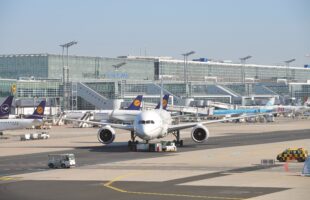During the first quarter of 2017, Frankfurt Airport (FRA) has continued its growth path: for the first time in the airport’s history, more than 13 million passengers passed through Germany’s largest aviation hub in the January-to-March period. This corresponds to a 1.5 percent increase year-on-year. Without the leap-year effect, a number of strikes and the late timing of the Easter holidays in 2017, the growth rate would have reached 3.1 percent. Cargo throughput (airfreight + airmail) also posted positive growth in the first three months of 2017, rising by 5.8 percent to 535,764 metric tons. Aircraft movements decreased by 1.2 percent to a total of 104,530 takeoffs and landings, while accumulated maximum takeoff weights (MTOWs) were down 2.6 percent to about 6.7 million metric tons. Adjusted for the special effects, aircraft movements would have increased by 0.3 percent.
In March 2017, Frankfurt Airport served some 4.9 million passengers, up 1.8 percent year-on-year. Thus, the previous March record achieved in 2016 was exceeded by around 85,000 passengers. Without a number of flight cancellations, mainly due to strikes at airports in Berlin, passenger traffic would have increased by 2.3 percent. Cargo volumes soared by 9.8 percent to 205,443 metric tons – the highest monthly growth rate recorded over the previous six years. This was helped by a more favorable timing of weekdays compared to the previous year and the fact that Easter falls in April this year. The number of aircraft movements rose by 1.1 percent to 37,924 takeoffs and landings in March 2017. With approximately 2.4 million metric tons, maximum takeoff weights shrank by 1.0 percent compared to the same month of the previous year.
Across the Group, airports in Fraport’s international portfolio showed largely positive performance in the first quarter of 2017. Ljubljana Airport (LJU) in the capital of Slovenia welcomed 288,355 passengers in the first three months of the year, an increase of 17.5 percent. Lima Airport (LIM) in Peru recorded a 7.4 percent increase to about 4.8 million passengers. The two Twin Star airports of Varna (VAR) and Burgas (BOJ) on the Bulgarian Black Sea coast, combined, served 126,033 passengers, thus posting growth of 7.6 percent. By contrast, the airports of Antalya (AYT) in Turkey and Hanover (HAJ) in northern Germany registered declines of 10.1 percent to some 2.1 million passengers and 2.8 percent to 979,658 passengers, respectively. Pulkovo Airport (LED) in St. Petersburg, Russia, saw traffic improve by 25.3 percent to almost 2.9 million passengers in the first quarter of 2017, while Xi’an Airport (XIY) in China welcomed more than 9.8 million passengers, an increase of 14.4 percent.








